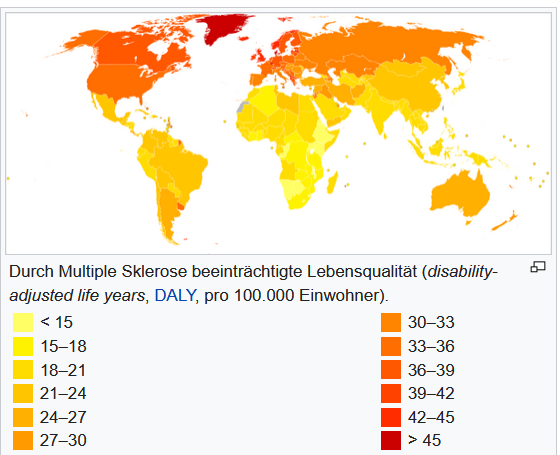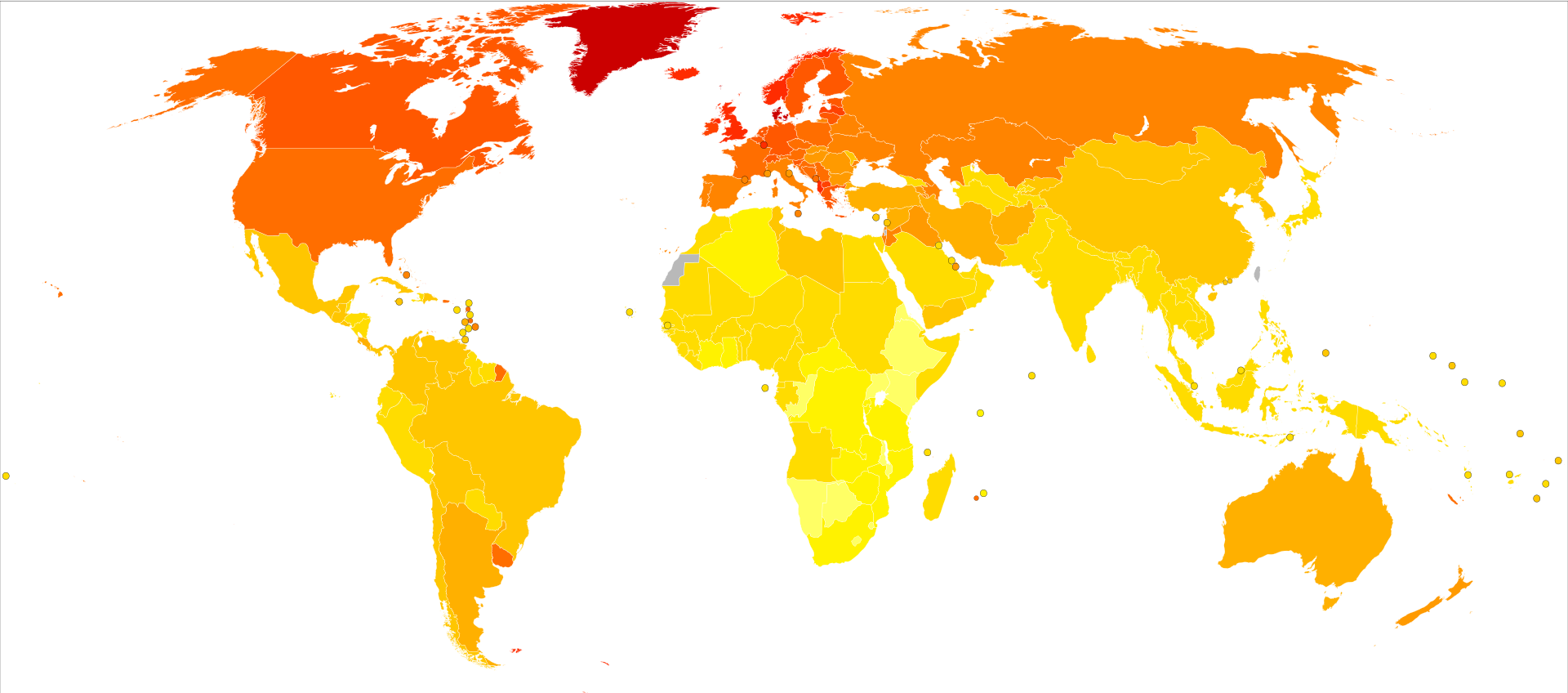On January 10, 2024, a very exciting paper was published in Nature that addresses a previously under-researched aspect of the autoimmune disease multiple sclerosis. A large international team led by Professor Eski Willerslev from the Universities of Cambridge and Copenhagen, Professor Thomas Werg from the University of Copenhagen and Professor Rasmus Nielsen from the University of California, Berkeley, participated in the study. With contributions from 175 researchers from around the world.
In MS, the myelin sheaths of nerve fibers in the central nervous system are broken down by the immune system, which can lead to sensory impairment. Symptoms appear in spurts and can often disappear at first. However, permanent neurological deficits can occur later. There is currently no clear explanation for why the immune system attacks the body, and there is no cure. However, the course can be slowed and symptoms relieved.

From Lokal_Profil, CC BY-SA 2.5, https://commons.wikimedia.org/w/index.php?curid=8962898
MS affects approximately 2.5 million people worldwide, although the incidence varies from region to region. The greatest frequency is found in Europe. Northern Europeans appear to be the most vulnerable here. The aim of this paper was to answer why and how this disease was able to spread so widely on one continent compared to other regions of the world.
Risk factors
In order to effectively answer these questions, researchers first differentiate between potential risk factors. There are environmental influences such as pathogens and lifestyle influences such as smoking that affect the disease, but there are also genetic risk factors. Genome-wide association studies (GWAS) have revealed about 233 common genetic variants that promote MS. 32 of these genes are located in the HLA region, the human leukocyte antigen region. The “higher risk” gene variant, HLA-DRB1*15:01, triples the risk of developing multiple sclerosis. Unlike most environmental and lifestyle influences, genetic factors can be inherited and thus explain spatial distribution well.
Ancestral
Today, the ancestral diversity of the European population can be traced back to the following basic peoples: western hunter-gatherers, eastern hunter-gatherers, Caucasian hunter-gatherers, farmers and steppe people. In this paper, the researchers used a very large database of genomes from the Mesolithic, Bronze Age, and Medieval periods — genomes from the past 10,000 years.
“Creating a gene bank of ancient DNA from early humans in Eurasia has been an enormous project that will require collaboration with museums across the region.”
Eske Willerslev, a professor at the University of Cambridge and co-author of the study.
With the help of this database, they were able to determine which populations at that time carried genetic risk factors and how they spread. They discovered the HLA-DRB1*15:01 gene for the first time in an Italian Neolithic individual, identified by carbon dating as 5836 BC. They also found that these genes became increasingly common in steppe populations about 5,300 years ago, during the period of the Yamnaya culture. Steppe people make up a large part of the ancestry of northern European countries, such as Sweden and Finland. So this is also consistent with an increased incidence of MS in these areas. Thus, risk genes appear to come primarily from steppe populations. Conversely, it means that having steppe dwellers in your ancestors brings with it an increased likelihood of developing MS.
to choose
So after identifying the steppe population as having a basic ancestry with an increased risk of developing MS, the researchers asked themselves whether the prevalence of risk was due to positive selection, that is, natural selection. To do this, they used a number of methods, such as CLUES and PALM, and were able to determine that the increased risk of MS is actually spread through selection in steppe populations. This is done through selection that favors haplotypes with mixed ancestry, i.e. haplotypes that contain more than one ancestral group. This mechanism is actually well known because ancestral diversity provides some protection against deleterious mutations.
However, it is interesting that MS risk genes have spread through selection, because selection is usually found when it brings an evolutionary advantage, i.e. gives selected individuals some sort of advantage in survival or reproduction. Intuitively, this is not the case with MS. So the question arises, what advantage should MS risk bring?
“It must have been a clear advantage for the Yamnaya people to carry MS risk genes, even after their arrival in Europe, although these genes undoubtedly increased their MS risk.”
Eski Willerslev
Here the researchers' answers become speculative, because the databases they used contain very little data. For this reason they could only reach their conclusion based on circumstantial evidence. MS-causing genes, such as the HLA-DRB1*15:01 gene, appear to not only have the function of promoting MS, but also provide some level of protection against other diseases such as tuberculosis or parasites. These are diseases that became more and more common about 5,000 years ago, because population densities became greater and cross-infection became more likely. As a result, these genes were given a certain advantage over their less efficient variants, and thus spread through positive selection.
Conclusion
Multiple sclerosis is more common in northern regions of the world, such as Sweden, Finland and Norway. The reason for this exciting phenomenon was not clear for a long time until the research was published on January 10, 2024. Scientists found that most of the risk genes first appeared with increased probability in the steppe population, which is the ancestor of the northern European population. They have now identified the basic ancestors, but the next question is why steppe populations develop these risk genes in greater numbers compared to other populations that do not. Do these genes have an evolutionary advantage? Actually yes, they did. In addition to their risk function, they also provide a certain level of protection against diseases such as tuberculosis and parasites. This protection has become more important with the increasing spread of some diseases due to environmental influences and lifestyle. MS risk genes have undergone positive selection and can still be found in descendants of steppe people today.
If you are interested
Multiple Sclerosis: Between Research and Clinics, Multiple Sclerosis: Inflammation and Neurodegeneration, Multiple Sclerosis: The Disease with a Thousand Faces, A dose of myelin, please! – Vaccination against multiple sclerosis, multiple sclerosis, can kisses lead to multiple sclerosis?
sources
Barrie, W., Yang, Y., Irving-Pease, E. K., Attfield, K. E., Scorrano, G., Jensen, L. T., Armen, A. P., Dimopoulos, E. A., Stern, A. J., Refoyo-Martínez, A., Pearson, A., Ramsøe, A., Gaunitz, C., Demeter, F., Jørkov, M. L., Møller, S. B., Springborg, B., Klassen, L., Hyldgård, I. M., . . . Willerslev, E. (2024). An elevated genetic risk for multiple sclerosis has been demonstrated in steppe herder populations. nature, 625(7994), 321-328. https://doi.org/10.1038/s41586-023-06618-z
Medical news. (2024, January 15). Ancient genomes reveal origins of multiple sclerosis risk in Europe. https://www.news-medical.net/news/20240115/Ancient-genomes-reveal-origins-of-multiple-sclerosis-risk-in-Europe.aspx
Wexler, M. (2024, January 12). Ancient DNA reveals how genes causing MS spread across Europe Multiple Sclerosis News Today. https://multiplesclerosisnewstoday.com/news-posts/2024/01/12/ancient-dna-reveal-risk-genes-spread-across-europe/

“Total coffee aficionado. Travel buff. Music ninja. Bacon nerd. Beeraholic.”








More Stories
Coral Seeding: Artificial Insemination Makes Coral More Heat Tolerant
Fear, Anger, and Denial: How People Respond to Climate Change – Research
LKH Graz: Using radiation to combat heart arrhythmias